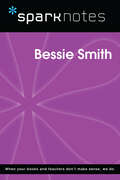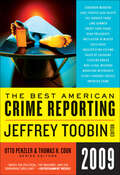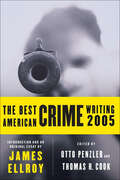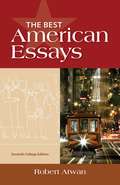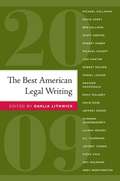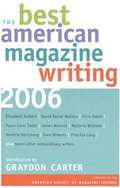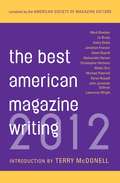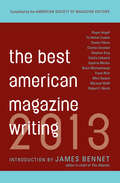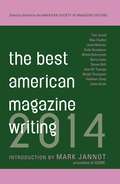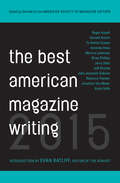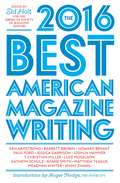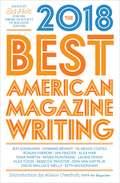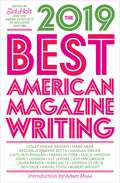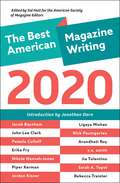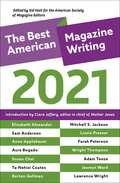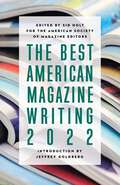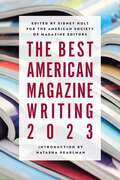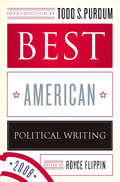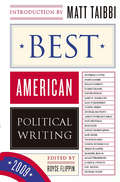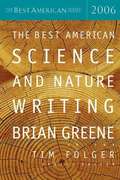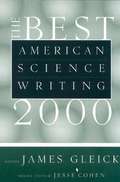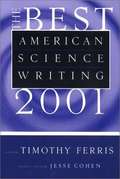- Table View
- List View
Bessie Smith (SparkNotes Biography Guide)
by SparkNotesBessie Smith (SparkNotes Biography Guide) Making the reading experience fun! SparkNotes Biography Guides examine the lives of historical luminaries, from Alexander the Great to Virginia Woolf. Each biography guide includes:An examination of the historical context in which the person lived A summary of the person&’s life and achievements A glossary of important terms, people, and events An in-depth look at the key epochs in the person&’s career Study questions and essay topics A review test Suggestions for further reading Whether you&’re a student of history or just a student cramming for a history exam, SparkNotes Biography guides are a reliable, thorough, and readable resource.
The Best American Crime Reporting 2009 (The Best American Series)
by Jeffrey Toobin, Otto Penzler and Thomas H. Cook“With consistently interesting content and beautiful writing, this collection will be devoured by fans of true crime and narrative nonfiction.” —Library JournalEdited by Jeffrey Toobin, CNN’s senior legal analyst and New York Times–bestselling author of The Nine, The Best American Crime Reporting 2009 is a must-have for the true crime reader, complete with the most gripping, suspenseful, and brilliant stories of the year by the masters of crime reporting. Featuring stories of fraud, murder, theft, and madness, the Best American Crime Reporting series has been hailed as “arresting reading” (People) and the best mix of “the political, the macabre, and the downright brilliant” (Entertainment Weekly).
The Best American Crime Writing 2005 (The Best American Series)
by James Ellroy“One of the strengths of this true-crime anthology series comes simply from its astonishing variety . . . it would be tough to better this collection.” —BooklistThe 2005 edition of The Best American Crime Writing offers the year’s most shocking, compelling, and gripping writing about real-life crime, including Peter Landesman’s article about female sex slaves (the most requested and widely read New York Times story of 2004), a piece from The New Yorker by Stephen J. Dubner (the coauthor of Freakanomics) about a high-society silver thief, and an extraordinarily memorable “ode to bar fights” written by Jonathan Miles for Men’s Journal after he punched an editor at a staff party. But this year’s edition includes a bonus—an original essay by James Ellroy detailing his fascination with Joseph Wambaugh and how it fed his obsession with crime—even to the point of selling his own blood to buy Wambaugh’s books. Smart, entertaining, and controversial, The Best American Crime Writing is an essential edition to any crime enthusiast’s bookshelf.“Great choices [and] great writing . . . proves truth is indeed stranger than fiction.” —Bloomberg News“Because these well-written articles vary widely, this work should appeal to all true-crime enthusiasts.” —Library Journal“A solid and diverse collection of true-crime writing . . . Anyone interested in true crime should find something to enjoy in this wide-ranging collection.” —Publishers Weekly
The Best American Essays, College Edition (Seventh Edition)
by Robert AtwanThis version of The Best American Essays is designed for college students and classroom use. The selection is based on length, topicality, diverse perspectives, and rhetorical and thematic variety. The book reflects the types of writing most often taught in introductory and even advanced composition courses. Suitable for various writing courses, it can be used in mainstream freshman composition programs with a focus on personal, expository, and argumentative essays.
The Best American Legal Writing 2009
by Dahlia LithwickThe Best American Legal American Writing 2009 introduces readers to the most informative and incisive writing on the subject of legal theory and practice published during the past year.
The Best American Magazine Writing 2004
by American Society of Magazine StaffThis stunning collection of features, essays, profiles, and reportage is comprised of all the winners and finalists for this year's National Magazine Awards.
The Best American Magazine Writing 2005
by American Society of Magazine EditorsIn the magazine world, no recognition is more highly coveted or prestigious than a National Magazine Award. Annually, members of the American Society of Magazine Editors in association with the Columbia University Graduate School of Journalism select the year's most dynamic, original, provocative, and influential magazine stories. The winning and finalist pieces in this anthology represent outstanding work by some of the most eminent writers in America as well as rising literary and journalistic talents.This collection celebrates excellence in several genres: investigative reporting, features, profiles, criticism, and essays. The stories cover a variety of subjects from Seymour Hersh's investigation into abuse at Abu Ghraib prison and Samantha Power's account of the genocide in Darfur to Ned Zeman's remarkable portrait of Timothy Treadwell, the man who lived with grizzlies, and David Kamp's piece on the extraordinary collaboration between Rick Rubin and Johnny Cash. Other pieces include Chris Jones on life at the International Space Station, James McManus on stem-cell research, Adam Gopnik on Times Square, Jed Perl on the redesign of the Museum of Modern Art, David Quammen on disputes about evolution, and James Wolcott on the blogosphere.Wide-ranging in their style and subjects, these pieces inform, surprise, entertain, and provide new perspectives on our world. They also reflect elements that distinguish the best in magazine writing: moral passion, investigative zeal, vivid characters and settings, persistent reporting, and artful writing.
The Best American Magazine Writing 2006
by American Society of Magazine EditorsIn the magazine world, no recognition is more highly coveted or prestigious than a National Magazine Award. Annually, members of the American Society of Magazine Editors, in association with the Columbia University Graduate School of Journalism, select the year's most dynamic, original, provocative, and influential magazine stories. The winning and finalist pieces in this anthology represent outstanding work by some of the most eminent writers in America as well as rising literary and journalistic talents. This collection celebrates excellence in investigative reporting, features, profiles, criticism, and essays. The stories cover a variety of subjects from Elizabeth Kolbert's investigation into global warming and Mimi Swartz's look at tort reform in Texas to Chris Heath's remarkable profile of Merle Haggard and David Samuel's brilliant piece on how Yasir Arafat destroyed Palestine. Other writers include James Fallows, David Foster Wallace, Marjorie Williams, Hendrik Hertzberg, Joyce Carol Oates, Sven Birkerts, Alex Wilkinson, and Priscilla Long. Wide-ranging in their style and subjects, these writers' stories inform, surprise, entertain, and provide new perspectives on our world. They also reflect elements that distinguish the best in magazine writing: moral passion, investigative zeal, vivid characters and settings, persistent reporting, and artful writing.
The Best American Magazine Writing 2012
by American Society of Magazine EditorsChosen from the 2012 National Magazine Awards finalists and winners, this anthology is filled with compelling features and profiles, eye-opening reporting, and incisive criticism and analysis of contemporary culture and society. Written by today's leading journalists, the selections cover a range of developments in politics, international affairs, culture, and business--from the increasingly short shelf lives of celebrity marriages to the ongoing fallout from Wall Street's financial malpractice, from the insidious effects of the lingering wars in Iraq and Afghanistan to the resurgent battle over issues pertaining to women's safety and health. Always engaging and informative, Best American Magazine Writing 2012 is an incomparable resource for the most noteworthy journalism and literary achievements of the year.<P><P> Essays include Lawrence Wright (The New Yorker) on the history of Scientology and recent challenges to its mission and methods; Matthieu Aikins (The Atlantic) on the shady dealings and shifting sands of the war in Afghanistan; the late Christopher Hitchens (Vanity Fair) on the physical and emotional toll of cancer; and Joel Stein (Time) on the propensity for politicians and other popular figures to get into trouble on the Internet. John Jeremiah Sullivan (GQ) immerses himself in David Foster Wallace's curious legacy; Tim Crothers (ESPN) follows the inspiring story of Phiona Mutesi, a chess prodigy from the slums of Uganda; Chris Ballard (Sports Illustrated) recounts Dewayne Dedmon's struggle to reconcile his faith with a career in sports; Wesley Yang (New York) explores the pressure on Asian Americans to succeed and the psychological and cultural consequences when they don't; and Luke Dittrich (Esquire) shares the raw experiences of those who survived one of 2011's worst natural disasters: the tornado that hit Joplin, Missouri. The sparkling dialogue and vividly imagined, eccentric characters of Karen Russell's award-winning short story, "The Hox River Window" (Zoetrope: All-Story), rounds out the collection.
The Best American Magazine Writing 2013
by American Society of Magazine EditorsChosen by the American Society of Magazine Editors, the stories in this anthology include National Magazine Award–winning works of public interest, reporting, feature writing, and fiction. This year's selections include Pamela Colloff (Texas Monthly) on the agonizing, decades-long struggle by a convicted murderer to prove his innocence; Dexter Filkins (The New Yorker) on the emotional effort by an Iraq War veteran to make amends for the role he played in the deaths of innocent Iraqis; Chris Jones (Esquire) on Robert A. Caro's epic, ongoing investigation into the life and work of Lyndon Johnson; Charles C. Mann (Orion) on the odds of human beings' survival as a species; and Roger Angell (The New Yorker) on aging, dying, and loss. The former infantryman Brian Mockenhaupt (Byliner) describes modern combat in Afghanistan and its ability both to forge and challenge friendships; Ta-Nehisi Coates (The Atlantic) reflects on the complex racial terrain traversed by Barack Obama; Frank Rich (New York) assesses Mitt Romney's ambiguous candidacy; and Dahlia Lithwick (Slate) looks at the current and future implications of an eventful year in Supreme Court history. The volume also includes an interview on the art of screenwriting with Terry Southern from The Paris Review and an award-winning short story by Stephen King published in Harper's magazine.
The Best American Magazine Writing 2014
by American Society of Magazine EditorsOur annual anthology of finalists and winners of the National Magazine Awards 2014 includes Max Chafkin's oral history of Apple from Fast Company, Joshua Davis's intimate portrait of tech pioneer John McAfee's personal and public breakdown from Wired; Kyle Dickman's haunting investigation into the preventable death of nineteen firemen battling an Arizona wildfire; and Ariel Levy's emotional account of extreme travel to a remote land—while pregnant—from The New Yorker.Other essays include Wright Thompson's bittersweet profile of Michael Jordan's fifty-something second act (ESPN the Magazine); Jean M. Twenge's revealing look at fertility myths and baby politics (The Atlantic); Janet Reitman's controversial study of the Boston Marathon bomber Dzhokhar Tsarnaev (Rolling Stone); Luke Mogelson's harrowing experience accompanying asylum seekers on a potentially deadly sea voyage to Australia (New York Times Magazine); Lisa Miller's poignant report from Newtown, Connecticut, as the town tries to cope with the aftermath of one of the nation's worst mass shootings (New York); Emily Nussbaum's critiques of gender and politics on television (The New Yorker); and Witold Rybczynski's poetic engagement with modern architecture (Architect). The collection concludes with the award-winning poem "Elegies" by Kathleen Ossip (Poetry) and "The Embassy of Cambodia," a short story by Zadie Smith (The New Yorker).
The Best American Magazine Writing 2015
by American Society of Magazine EditorsThis year's Best American Magazine Writing features articles on politics, culture, sports, sex, race, celebrity, and more. Selections include Ta-Nehisi Coates's intensely debated "The Case For Reparations" (The Atlantic) and Monica Lewinsky's reflections on the public-humiliation complex and how the rules of the game have (and have not) changed (Vanity Fair). Amanda Hess recounts her chilling encounter with Internet sexual harassment (Pacific Standard) and John Jeremiah Sullivan shares his investigation into one of American music's greatest mysteries (New York Times Magazine).The anthology also presents Rebecca Traister's acerbic musings on gender politics (The New Republic) and Jerry Saltz's fearless art criticism (New York). James Verini reconstructs an eccentric love affair against the slow deterioration of Afghanistan in the twentieth century (The Atavist); Roger Angell offers affecting yet humorous reflections on life at ninety-three (The New Yorker); Tiffany Stanley recounts her poignant experience caring for a loved one with Alzheimer's (National Journal); and Jonathan Van Meter takes an entertaining look at fashion's obsession with being a social-media somebody (Vogue). Brian Phillips describes his surreal adventures in the world of Japanese ritual and culture (Grantland), and Emily Yoffe reveals the unforeseen casualties in the effort to address the college rape crisis (Slate). The collection concludes with a work of fiction by Donald Antrim, exploring the geography of loss. (The New Yorker).
The Best American Magazine Writing 2016
by Sid HoltThis year's Best American Magazine Writing features outstanding writing on contentious issues including incarceration, policing, sexual assault, labor, technology, and environmental catastrophe. Selections include Paul Ford's ambitious "What Is Code?" (Bloomberg Businessweek), an innovative explanation of how programming works, and "The Really Big One," by Kathryn Schulz (The New Yorker), which exposes just how unprepared the Pacific Northwest is for a major earthquake. Joining them are Meaghan Winter's exposé of crisis pregnancy centers (Cosmopolitan) and a chilling story of police prejudice that allowed a serial rapist to run free (the Marshall Project in partnership with ProPublica). Also included is Shane Smith's interview with Barack Obama about mass incarceration (Vice). Other selections demonstrate a range of long-form styles and topics across print and digital publications. The imprisoned hacker and activist Barrett Brown pens hilarious dispatches from behind bars, including a scathing review of Jonathan Franzen's fiction (The Intercept). "The New American Slavery" (Buzzfeed) documents the pervasive exploitation of guest workers, and Luke Mogelson explores the purgatorial fate of an undocumented man sent back to Honduras (New York Times Magazine). Joshua Hammer harrowingly portrays Sierra Leone's worst Ebola ward as even the staff succumb to the disease (Matter). And in "The Friend," Matthew Teague's wife is afflicted with cancer, his friend moves in, and the result is a devastating narrative of relationships and death (Esquire). The collection concludes with Jenny Zhang's "How It Feels," an unconventional meditation on the intersection of teenage cruelty and art (Poetry).
The Best American Magazine Writing 2018
by Sid HoltIn a time of reckoning, this year’s National Magazine Awards finalists and winners focus on abuse of power in many forms. Ronan Farrow’s Pulitzer Prize–winning revelation of Harvey Weinstein’s depredations (New Yorker), along with Rebecca Traister’s charged commentary for New York and Laurie Penny’s incisive Longreads columns, speak to the urgency of the #MeToo moment. Ginger Thompson’s reporting on the botched U.S. operation that triggered a cartel massacre in Mexico (National Geographic/ProPublica) and Azmat Khan and Anand Gopal’s New York Times Magazine investigation of the civilian casualties of drone strikes in Iraq amplify the voices of those harmed by U.S. actions abroad. And Alex Tizon’s “My Family’s Slave” (Atlantic) is a powerful attempt to come to terms with the cruelty that was in plain sight in his own upbringing.Responding to the overt racism of the Trump era, Ta-Nehisi Coates’s “My President Was Black” (Atlantic) looks back at the meaning of Obama. Howard Bryant (ESPN the Magazine) and Bim Adewunmi (Buzzfeed) offer incisive columns on the intersections of pop culture, sports, race, and politics. In addition, David Wallace-Wells reveals the coming disaster of our climate-change-ravaged future (New York); Don Van Natta Jr. and Seth Wickersham’s ESPN the Magazine reporting exposes the seamy sides of the NFL; Nina Martin and Renee Montagne investigate America’s shameful record on maternal mortality (NPR/ProPublica); Ian Frazier asks “What Ever Happened to the Russian Revolution?” (Smithsonian); and Alex Mar considers “Love in the Time of Robots” (Wired with Epic Magazine). The collection concludes with Kristen Roupenian’s viral hit short story “Cat Person” (New Yorker).
The Best American Magazine Writing 2019
by Sid HoltThe Best American Magazine Writing 2019 presents articles honored by this year’s National Magazine Awards, showcasing outstanding writing that addresses urgent topics such as justice, gender, power, and violence, both at home and abroad. The anthology features remarkable reporting, including the story of a teenager who tried to get out of MS-13, only to face deportation (ProPublica); an account of the genocide against the Rohingya in Myanmar (Politico); and a sweeping California Sunday Magazine profile of an agribusiness empire. Other journalists explore the indications of environmental catastrophe, from invasive lionfish (Smithsonian) to the omnipresence of plastic (National Geographic).Personal pieces consider the toll of mass incarceration, including Reginald Dwayne Betts’s “Getting Out” (New York Times Magazine); “This Place Is Crazy,” by John J. Lennon (Esquire); and Robert Wright’s “Getting Out of Prison Meant Leaving Dear Friends Behind” (Marshall Project with Vice). From the pages of the Atlantic and the New Yorker, writers and critics discuss prominent political figures: Franklin Foer’s “American Hustler” explores Paul Manafort’s career of corruption; Jill Lepore recounts the emergence of Ruth Bader Ginsburg; and Caitlin Flanagan and Doreen St. Félix reflect on the Kavanaugh hearings and #MeToo. Leslie Jamison crafts a portrait of the Museum of Broken Relationships (Virginia Quarterly Review), and Kasey Cordell and Lindsey B. Koehler ponder “The Art of Dying Well” (5280). A pair of never-before-published conversations illuminates the state of the American magazine: New Yorker writer Ben Taub speaks to Eric Sullivan of Esquire about pursuing a career as a reporter, alongside Taub’s piece investigating how the Iraqi state is fueling a resurgence of ISIS. And Karolina Waclawiak of BuzzFeed News interviews McSweeney’s editor Claire Boyle about challenges and opportunities for fiction at small magazines. That conversation is inspired by McSweeney’s winning the ASME Award for Fiction, which is celebrated here with a story by Lesley Nneka Arimah, a magical-realist tale charged with feminist allegory.
The Best American Magazine Writing 2020
by American Society of Magazine EditorsThe Best American Magazine Writing 2020 brings together outstanding writing, from in-depth reporting to incisive criticism. The anthology features excerpts from major projects that challenge American certitudes: the Washington Post Magazine’s “Prison” issue, detailing the scope of mass incarceration, and the New York Times Magazine’s “The 1619 Project,” which recenters the nation’s history around slavery and its legacies. It includes extraordinary globe-spanning journalism, including pieces on the genocide against the Rohingya (New York Times Magazine) and the unintended consequences of a dengue fever vaccine (Fortune). Pamela Colloff details prosecutors’ reliance on an untrustworthy jailhouse informant (New York Times Magazine in partnership with ProPublica), and a ProPublica series investigates the disaster that befell the USS Fitzgerald.The anthology showcases the work of remarkable stylists, including Jia Tolentino’s cultural commentary (New Yorker) and Ligaya Mishan’s columns on food and culture (T: The New York Times Style Magazine). Columns by s.e. smith consider disability (Catapult), and the DeafBlind poet John Lee Clark writes about art he can touch (Poetry). Jordan Kisner visits a Martha Washington–themed debutante ball in Texas near the Mexican border for The Believer, and Jacob Baynham offers a moving portrait of his father-in-law (Georgia Review). Arundhati Roy excoriates the increasing authoritarianism of Modi’s India (The Nation in partnership with Type Media Center). The anthology concludes with Jonathan Escoffery’s short story of homesickness for Jamaica, “Under the Ackee Tree” (Paris Review).
The Best American Magazine Writing 2021
by Sid HoltThe Best American Magazine Writing 2021 presents outstanding journalism and commentary that reckon with urgent topics, including COVID-19 and entrenched racial inequality. In “The Plague Year,” Lawrence Wright details how responses to the pandemic went astray (New Yorker). Lizzie Presser reports on “The Black American Amputation Epidemic” (ProPublica). In powerful essays, the novelist Jesmyn Ward processes her grief over her husband’s death against the backdrop of the pandemic and antiracist uprisings (Vanity Fair), and the poet Elizabeth Alexander considers “The Trayvon Generation” (New Yorker). Aymann Ismail delves into how “The Store That Called the Cops on George Floyd” dealt with the repercussions of the fatal call (Slate). Mitchell S. Jackson scrutinizes the murder of Ahmaud Arbery and how running fails Black America (Runner’s World).The anthology features remarkable reporting, such as explorations of the cases of children who disappeared into the depths of the U.S. immigration system for years (Reveal) and Oakland’s efforts to rethink its approach to gun violence (Mother Jones). It includes selections from a Public Books special issue that investigate what 2020’s overlapping crises reveal about the future of cities. Excerpts from Marie Claire’s guide to online privacy examine topics from algorithmic bias to cyberstalking to employees’ rights. Aisha Sabatini Sloan’s perceptive Paris Review columns explore her family history in Detroit and the toll of a brutal past and present. Sam Anderson reflects on a unique pop figure in “The Weirdly Enduring Appeal of Weird Al Yankovic” (New York Times Magazine). The collection concludes with Susan Choi’s striking short story “The Whale Mother” (Harper’s Magazine).
The Best American Magazine Writing 2022
by Sid HoltThe Best American Magazine Writing 2022 presents a range of outstanding writing on timely topics, from in-depth reporting to incisive criticism: Kristin Canning calls for a change in how we talk about abortion (Women’s Health), and Ed Yong warns us about the next pandemic (The Atlantic). Matthieu Aikins provides a gripping eyewitness account of the Taliban’s seizure of Kabul (New York Times Magazine). Heidi Blake and Katie J. M. Baker’s “Beyond Britney” examines how people placed under legal guardianship are deprived of their autonomy (BuzzFeed News). Rachel Aviv profiles a psychologist who studies the fallibility of memory—and has testified for defendants including Harvey Weinstein and Bill Cosby (The New Yorker).The anthology includes dispatches from the frontiers of science, exploring why Venus turned out so hellishly unlike Earth (Popular Science) and detailing the potential of NASA’s James Webb Space Telescope (Quanta). It features celebrated writers, including Harper’s magazine pieces by Ann Patchett, whose “These Precious Days” is a powerful story of friendship during the pandemic, and Vivian Gornick, who offers “notes on humiliation.” Carina del Valle Schorske depicts the power of public dance after pandemic isolation (New York Times Magazine). And the NBA icon Kareem Abdul-Jabbar lauds the Black athletes who fought for social justice (AARP the Magazine). Amid the continuing reckoning with racism, authors reconsider tarnished figures. The Black ornithologist and birder J. Drew Lanham assesses the legacy of John James Audubon in the magazine that bears his name, and Jeremy Atherton Lin questions his youthful enthusiasm for Morrissey (Yale Review). Jennifer Senior writes about memory and the lingering grief felt for a friend killed on 9/11 (The Atlantic). The collection concludes with Nishanth Injam’s story of queer first love across religious boundaries, “Come with Me” (Georgia Review).
The Best American Magazine Writing 2023
by Sidney HoltThe Best American Magazine Writing 2023 offers a selection of outstanding journalism on timely topics, including inequalities and injustices pressuring families, especially mothers. Rozina Ali tells the story of a U.S. marine who unlawfully adopted an Afghan girl and her family’s efforts to bring her home (New York Times Magazine). A Mother Jones exposé confronts the imprisonment of women for failing to protect their children from their abusive partners. “The Landlord and the Tenant” juxtaposes the lives of a poor single mother convicted for her children’s deaths in a fire and the man who owned the fatal property (ProPublica with Milwaukee Journal Sentinel). Caitlin Dickerson investigates the history of the U.S. government’s family-separation policy (The Atlantic). Jia Tolentino’s New Yorker commentary considers abortion in a post-Roe world.The anthology features pieces on a wide range of subjects, such as Nate Jones on the “Nepo Baby” and Allison P. Davis’s essay about a decade on Tinder (New York). Natalie So recounts how her mother’s small computer chip company became the target of a Silicon Valley crime ring (The Believer). Clint Smith asks what Holocaust memorials in Germany can teach the United States about our reckoning with slavery (The Atlantic). Esquire’s Chris Heath examines the FBI’s involvement in a plot to kidnap the governor of Michigan. Courtney Desiree Morris takes a queer psychedelic ramble through New Orleans (Stranger’s Guide). Namwali Serpell reflects on representations of sex workers (New York Review of Books). An ESPN Digital investigation uncovers Penn State’s other serial sexual predator before Jerry Sandusky. Profiles of the acclaimed actress Viola Davis (New York Times Magazine) and the self-taught artist Matthew Wong (New Yorker), as well as Michelle de Kretser’s short story “Winter Term” (Paris Review), round out the volume.
Best American Political Writing 2008
by Royce FlippinAn anthology of the very best of American political journalism in a singularly exciting political year.
Best American Political Writing 2009
by Royce FlippinA must-have anthology for political junkies, Best American Political Writing compiles the year's best political stories from a variety of publications and points of view, in a single, comprehensive volume. Culling from the most memorable reporting of what promises to be a thrilling political year, the 2009 American Political Writing edition will include incisive coverage of the new Obama presidency and its impact nationwide, as well as the most pressing political concerns facing America today-from the depressed economy to our participation in wars in Iraq and Afghanistan.
The Best American Science and Nature Writing 2000
by David QuammenWith the inaugural volume of THE BEST AMERICAN SCIENCE AND NATURE WRITING, Houghton Mifflin showcases the finest writing of the past year on subjects of ever-increasing interest to readers. Guest editor David Quammen and series editor Burkhard Bilger have assembled a remarkable group of essays that originally appeared in periodicals from National Geographic, Science, and The New Yorker to Puerto del Sol and DoubleTake. Among the acclaimed writers represented are Natalie Angier on "Men, Women, Sex, and Darwin," Peter Matthiessen exploring "The Island at the End of the Earth," Richard Preston considering "The Demon in the Freezer," and Oliver Sacks remembering the "Brilliant Light" of his boyhood. Also including work by such literary lights as Anne Fadiman, Edward Hoagland, and Cullen Murphy, this volume presents selections bound together by their timelessness.
The Best American Science and Nature Writing 2006
by Brian GreeneBestselling author Brian Greene edits this year's volume of the finest science and nature writing. Contributors include Walter Kirn, Ron Rosenbaum, Jeffrey Toobin, and Oliver Sacks as well as many others.
The Best American Science Writing 2000
by James GleickThis offers glimpses of new realms of discovery and thought, exploring scientific territory that is unfamiliar to most of us, and an introduction to a collection of science writers and thinkers.
The Best American Science Writing 2001
by Timothy FerrisThis anthology presents 22 essays and a poem (by John Updike) published during 2001 in various publications, and an introduction by guest editor/science writer Ferris. Among the contributors: Freeman Dyson, Stephen Jay Gould, Tracy Kidder; topics run the gamut.
